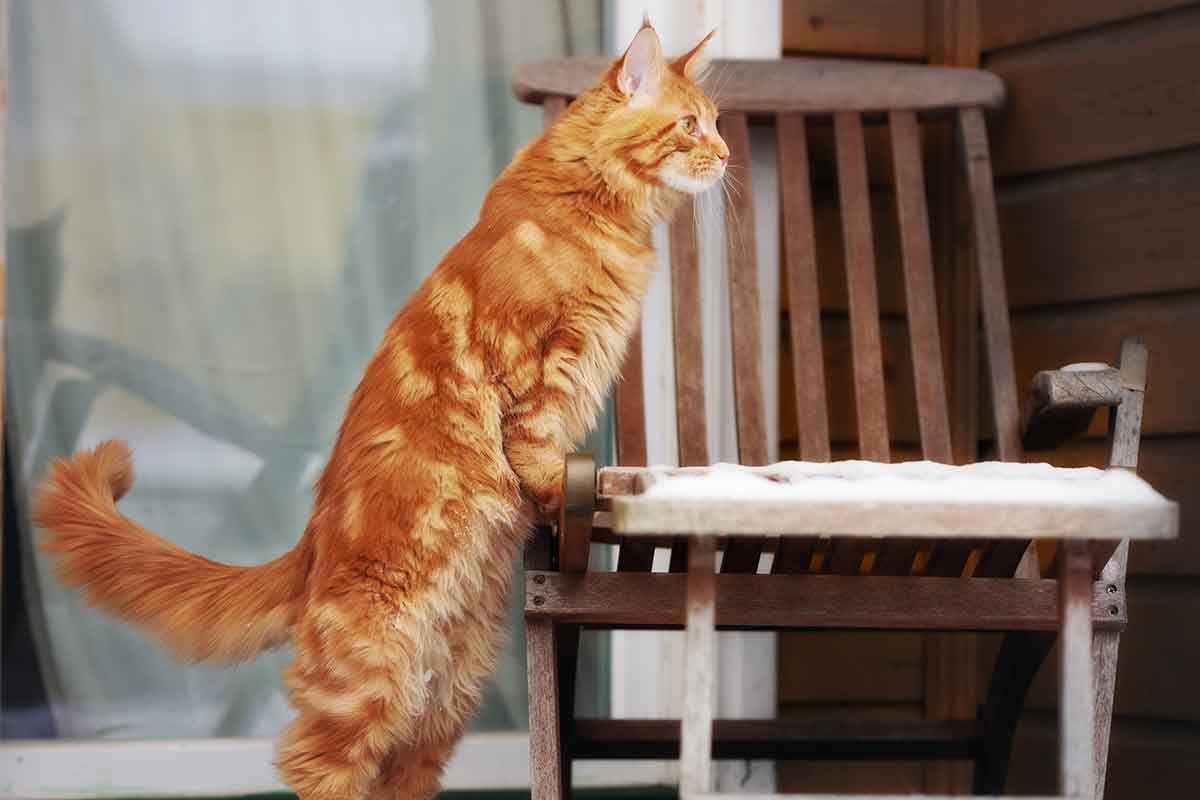From bobtail to slender “whippy” to magnificent plume, cats carry their tails proudly. Like a semaphore flag, the feline tail is a visual signal that communicates emotions up close and at a distance. Flexible, the tail moves up, down, high and low, back and forth. It may be straight, curved entirely, or curved only at the tip. Variable speed control takes the tail from completely still to full-throttle thrashing fast enough to rival Tesla’s Ludicrous Mode. As an added visual, the fur can change from smooth and flat to bottle brush bristled. Let’s decode what different tail positions signal in Felinese.
Straight Up
A cat whose tail is straight up is happy and confident, comfortable in the environment. You could read this as a signal expressing an interest in engaging with you. A lighthearted flick of the tip is a friendly greeting. Reciprocate with a show of affection.
A variation of the straight-up theme is straight up with a hook at the tip. This is a jaunty invitation to interact and the tail flick may be even more accentuated.
Straight up with a quiver of anticipation: Your cat is shaking with delight, excitement, and yes, anticipation of something delightful, usually a treat or food.
A straight-up tail that resembles a bottle brush is a cautionary signal announcing in all its fluffed-up glory that the cat feels threatened. To avoid a fight, cats puff up to look larger so as to frighten away a would-be threat. Give the cat some space and time to calm down.
The puffed-up bottle-brush tail has another variation. When the puffed tail drops from straight to an inverted “L,” with the first inch or so of the base straight from the body then dropping toward the ground, this cat feels under direct threat and is prepared to fight. The posture signals a high level of aggression. The bristled fur is an attempt to look more threatening to an opponent to ward off a fight, but the cat is willing to fight if necessary. It’s a clear sign to back off!
Horizontal
A relaxed horizontal tail carriage represents a relaxed cat. The tail may be in a slight U-shape. The general indication is cool, calm, collected. Overall, both body and tail should appear loose and casual.
A low horizontal tail indicates an uneasy, unhappy kitty who feels fearful and prefers to be left alone, please. Respect the wish. An attempt to socialize could result in an aggressive flareup.
Tucked
A tucked tail is a universal sign that the cat feels overwhelmingly threatened by something in the surroundings.
Wrapped
Cats often sit or sleep with their tail wrapped around their paws or body. This generally means the cat is relaxed but has activated the Do Not Disturb sign. It’s important to note the full body cues to determine if the cat wishes alone time or feels anxious. As levels of fear, anxiety, and stress increase, the tail moves closer and tighter to the body. In milder signs of fear, anxiety, and stress, the tail tip may flick slightly.
Swishy, Twitchy
A swishy or twitchy tail signals excitement. Some cats express joy with a swishy tail, but for others it may mean slight irritation. Often while cats are watching prey, the tail swish shifts to twitch as excitement increases. Look at other body indicators for more clues.
Thrashing
Thrashing, slapping, or thumping clearly signal agitation. If your cat’s tail is moving this way, she has had enough of petting, grooming, or other interaction. Your cat is telling you in the strongest way possible to stop what you’re doing. Unlike a dog’s rapid happy wagging tail, approaching a cat with this tail movement often results in a swift paw swipe. Leave the cat alone.
Wind And Entwined
A sign of pure feline affection among friends, whether those friends are another cat, a dog or other pet, or a human family member. Your cat may wind her tail around your leg or drape it over you as you sit next to each other. It’s an unspoken term of endearment.
Cats have a rich, extensive, expressive body language vocabulary. Once we learn the basic meanings, consider our own cat’s quirks, and take in the surrounding environment, we can recognize and heed warning signs before they escalate to aggression. We definitely want to recognize the signs of affection and reciprocate them for a long, loving relationship.
This article was reviewed/edited by board-certified veterinary behaviorist Dr. Kenneth Martin and/or veterinary technician specialist in behavior Debbie Martin, LVT.








